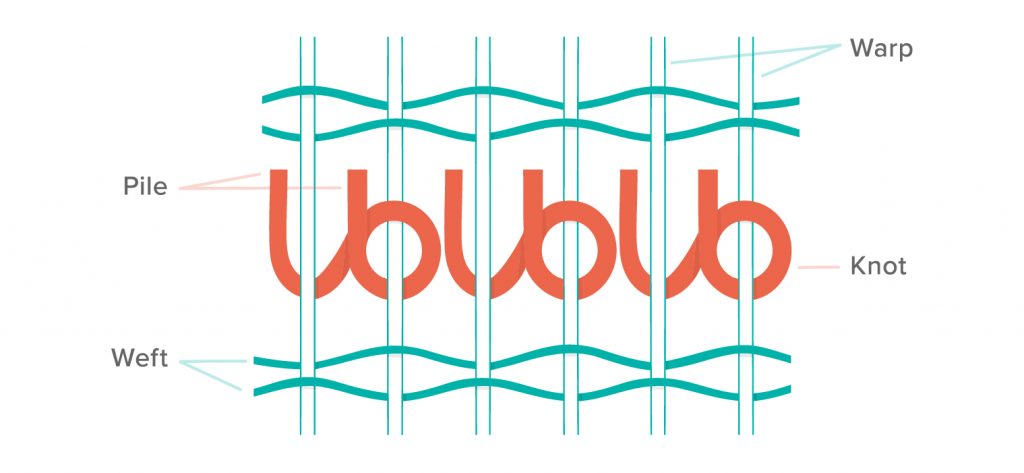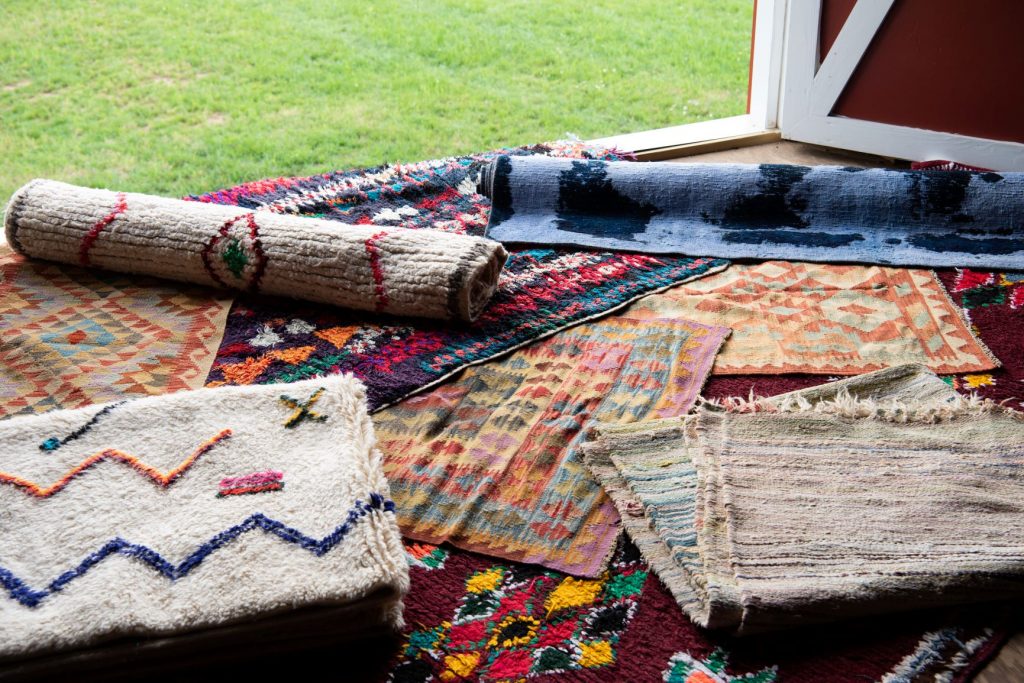In the world of rugs, there are two main types of rug: handmade rugs and machine-made rugs. Machine-made rugs represent the vast majority of rugs sold today and are a great choice for most consumers. However, machine-made rugs will rarely approach the quality and durability found in handmade Persian and Oriental rugs.
Because handmade rugs tend to be more expensive than their machine-made counterparts, you’ll want to know if your new rug is authentic. In this article, we’ll introduce some basic terms when it comes to handmade rug construction and how to tell them apart from machine-made rugs.
Handmade Rug Lingo
When you enter the world of fine handmade rugs, it can feel like you’re learning a new language. Don’t let this deter you, though! The terms you need to know aren’t as complicated as they seem, and once you can talk the talk, you’ll find it much easier to communicate what you are looking for and make the right decision when it comes to your rug.
Warp, weft, and pile
All rugs are made with at least three different yarns or fibers, named based on how they are used in the rug.

The “warp” of the rug is the (usually cotton) foundational fibers that run its length. The “weft” are the foundational fibers that run the rug’s width. Pile yarns are typically dyed wool or silk and are knotted into the warp of the rug forming the rug’s design and texture.
Hand-knotted rugs vs. hand-tufted rugs
All “true” Oriental rugs are hand knotted. In this intricate and labor-intensive process, the warp is stretched vertically across a wooden loom. Line-by-line, artisans will individually knot the pile onto the warp, weave in the weft, and tightly pack the yarns together with a heavy comb. Through this process, the weavers make the foundation of the rug as they go, and the pile becomes an important part of the rug’s overall construction. The result is an extremely durable, yet still soft and flexible work of art.
By contrast, hand-tufted rugs begin with a stiff foundation usually made of jute or canvas. Workers then punch the pile of the rug through this foundation using an air-powered “tufting gun,” usually while following a pattern that has been traced or printed onto the material. The pile is then sheared and held in place with glue and a backing material like latex. This process requires much less skill than hand knotting, so hand-tufted rugs can be made far more quickly.
Handwoven rugs and kilims
There’s a third type of handmade rug that doesn’t have a pile at all: handwoven rugs. This style of rug goes by many names including soumak, dhurrie and most commonly, the Turkish word “kilim.” Unlike other types of rug, handwoven rugs and kilims have no knots and no tufts. Instead, colorful weft yarns are woven through the warp to form the pattern of the rug. The result is a light, durable and often reversible floor covering. Traditionally, kilims are tribal rugs, and as such tend to have more “edgy” geometric patterns rather than the elaborate and intricate floral patterns and medallions common on “city” rugs including most pile rugs.
Persian rugs vs. Oriental rugs
“Persian” is an often-misapplied label. In truth, Persian rugs are specifically hand-knotted rugs made in Iran. The techniques used in Persian rugs date back thousands of years to the ancient Persian empire and are used to make intricate patterns with unparalleled precision and detail. The unmatched quality of Persian rugs along with their relative rarity in the US thanks to trade sanctions makes them highly prized by collectors.
“Oriental”, on the other hand, is an umbrella term that can apply to rugs made in a wide range of countries, from Egypt and Turkey to Pakistan, China, India, and, yes, Iran. This means that while all Persian rugs are Oriental, not all Oriental rugs are Persian. Moroccan rugs are also sometimes considered Oriental but are distinct enough that many people consider them a separate category.
Historically, Persian rugs have been top dogs in terms of quality, but their increasing rarity has encouraged weavers from outside Iran to adopt Persian designs and techniques.
SHOP PERSIAN AND ORIENTAL RUGS
How to Tell Your Handmade Rug is Authentic
Now that you know a little more about how hand-knotted rugs are made, let’s dig deeper into how they differ from machine-made rugs and how to tell the two apart.
Check the back
The easiest way to tell whether you have a real hand-knotted rug is to check the back. As stated above, the pile of hand-knotted rugs is tied directly into the warp, whereas machine-made rugs will be pushed through and held in place with glue and an additional backing material like what’s found in hand-tufted rugs. The back of a hand-knotted rug should be soft and flexible, with clearly visible knots in a pattern that mirrors the front of the rug. If some of those knots appear looser than others, that’s a good sign! Even the most skilled artisans won’t be capable of machine-like precision, so some unevenness is an indicator that your rug is handmade
Check the dye
Genuine Oriental and Persian rugs are made with natural vegetable dyes that over the centuries have been found to not run. Checking if the dye is colorfast is a surefire way to tell if your rug is authentic or a cheap imitation. An easy way to check is to leave a damp cloth on it overnight. If any dye transfers to the cloth, it is not colorfast and risks running should you ever spill liquid on it in the future.
Check the fringe
In a real hand-knotted rug, the fringe is made from the excess warp yarns on either end of the rug after it has been cut out of the loom. Machine-made rugs will often emulate this look with a fringe that is either glued or sewn on after the fact. If your rug has a sewn-on fringe, it is not authentic—the fringe on hand-knotted rugs is always structural.
Check the material
Authentic Persian and Oriental rugs are always made with 100% natural fibers. Usually, this means a cotton foundation and pile made from wool, silk, or a combination of the two. If your rug contains any synthetic materials like polyester or polypropylene, it can’t be called a genuine Oriental rug.
Check the price
While this won’t be as reliable as checking how the rug is built, you should still consider price when searching for a hand-knotted rug. This is especially important when buying online.
For many people, hand-knotted rugs are investment pieces and family heirlooms. While we won’t say it’s impossible to get a good deal, you should expect to spend a little more on handmade rugs. Making a hand-knotted rug is a difficult and time-intensive process. It might take a team of skilled weavers a year or more to complete a room-sized rug, assuming they are working full-time. Price tags of several thousand dollars are justified when considering the cost of premium materials and, in the case of Persian Rugs, the price increase that comes with their scarcity. If you find a room-sized rug presenting itself as a genuine Persian or Oriental rug for only a few hundred dollars, there is a very good chance it is a fake.
Buying a Handmade Rug Online
If you choose to buy a hand-knotted rug online, pay close attention to the reputation of the site you are buying it from. Take your time, read reviews and testimonials, and look for buyer protection services and return policies. Pay close attention to any photos you find. Your dealer should be able to provide pictures of the rug from multiple angles that clearly show the hallmarks of a handmade rug that were discussed above. If you have any questions or want the additional assurance of a certificate of authenticity, don’t be afraid to call customer service! A reputable dealer will be more than willing to work with you.
At Rugs.com, we make sure to check all the boxes, so our customers feel confident in the online rug buying process. With decades of experience working with handmade and machine-made rugs, we strive to help every customer find the perfect rug for every room of their home. Check out our online collection of hand-knotted Persian and Oriental rugs to get started today! Or, if you’re not comfortable shopping online and happen to be in the Charlotte, NC area, stop by our Fort Mill showroom and see some of our huge inventory of hand-made rugs yourself!


It was mentioned that you want to look for warp, weft or pile when looking for a handmade rug. My mother is wanting to put a handmade rug in her living room. I will have to let her know about these tips in finding the right one.
This is very interesting information about hand made rugs